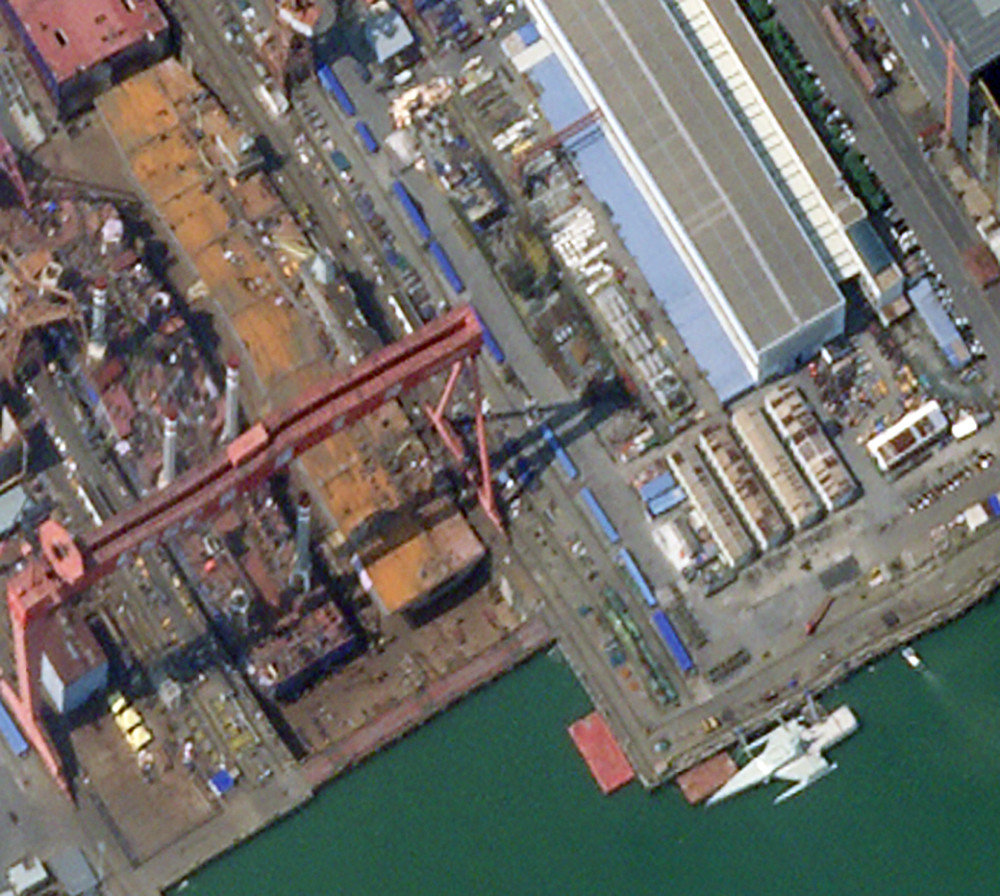Given the speed with which the large deck ship looks to be being constructed in Guangzhou, it may not be long before a fuller picture of its configuration and intended purpose now emerges.
New Chinese Mystery Flattop Emerges
The vessel, which appears to have been built very quickly, has features in line with an amphibious assault ship or small carrier.
- From what can be seen in satellite imagery, the ship has features in line with a light aircraft carrier or a big-deck amphibious assault ship, but there are some indications that it might be a first-of-its-kind ostensibly civilian ocean research vessel.
- China does have a long history of developing and fielding new maritime scientific research capabilities with clear potential military applicability.
 A satellite image of Guangzhou Shipyard International taken on October 23, 2024, showing, among other things, what looks to be a new class of Chinese ship with a large flight deck.
A satellite image of Guangzhou Shipyard International taken on October 23, 2024, showing, among other things, what looks to be a new class of Chinese ship with a large flight deck.
PHOTO © 2024 PLANET LABS INC. ALL RIGHTS RESERVED. REPRINTED BY PERMISSION
Tom Shugart, an adjunct senior fellow at the Center for a New American Security (CNAS) think tank, was among the first to spot the new ship under construction at Guangzhou Shipyard International (GSI) on Longxue Island just southeast of the city of Guangzhou.
Tom Shugart, an adjunct senior fellow at the Center for a New American Security (CNAS) think tank, was among the first to spot the new ship under construction at Guangzhou Shipyard International (GSI) on Longxue Island just southeast of the city of Guangzhou.
- Shugart’s attention had been drawn to the yard first by the appearance there of what looks to be a new high-speed trimaran uncrewed surface vessel (USV) that has reportedly been under construction in Guangzhou since at least 2022.
- An earlier Chinese trimaran USV design, which evoked the design of the U.S. Navy’s highly successful Sea Hunter, had previously emerged back in 2020.
In speaking with The War Zone, Shugart said there are also what might be exhaust stacks on the right side of the deck toward the stern. He further highlighted what looks to be an angular mast structure on top of the main island of a kind often seen in warships as a mount for radars and other sensors.
Overall, the ship’s size and what can be seen of its configuration are in line, at least in broad strokes, with many existing light aircraft carriers and big deck amphibious assault ships, such as Japan’s Hyuga class and China’s own Type 075.
 |
The new big deck ship at GSI also looks to have been built very quickly.
- There is no clear sign of it in high-resolution satellite imagery of GSI’s yard from May, but it is visible in a drydock there in August and looks to have been launched sometime between September 10 and October 9.
- A satellite image taken on October 23, seen earlier in this story, shows further progress, including what appears to be work to finish the surface of the flight deck.

PHOTO © 2024 PLANET LABS INC. ALL RIGHTS RESERVED. REPRINTED BY PERMISSION
The carrier-esque ship’s appearance at GSI’s yard is curious in itself. The shipbuilder is best known, at least publicly, for constructing larger commercial vessels, such as oil tankers, ore carriers, roll-on/roll-off cargo ships, and semi-submersible heavy lift types. Floating cranes and dry docks, and even marine wind turbines, are seen in past imagery.
At the same time, GSI’s work does have a clear military dimension.
The carrier-esque ship’s appearance at GSI’s yard is curious in itself. The shipbuilder is best known, at least publicly, for constructing larger commercial vessels, such as oil tankers, ore carriers, roll-on/roll-off cargo ships, and semi-submersible heavy lift types. Floating cranes and dry docks, and even marine wind turbines, are seen in past imagery.
At the same time, GSI’s work does have a clear military dimension.
- Previous satellite images show numerous Soviet-designed Zubr class heavy hovercraft, which China has built examples of domestically under license.
- Also visible are what CNAS’ Shugart says look to be large naval auxiliary type ships for the People’s Liberation Army Navy (PLAN), along with the new trimaran USV.
 Visible in the satellite image of the GSI yard taken on August 8 are a pair of Zubr class hovercraft (toward top right), a floating dry dock (toward the center), a floating crane (at bottom right), as well as the new big deck ship under construction dry dock (toward upper left) and and the apparent trimaran USV (at center). Also just visible at bottom right is one blade belonging to a maritime wind turbine. PHOTO © 2024 PLANET LABS INC. ALL RIGHTS RESERVED. REPRINTED BY PERMISSION
Visible in the satellite image of the GSI yard taken on August 8 are a pair of Zubr class hovercraft (toward top right), a floating dry dock (toward the center), a floating crane (at bottom right), as well as the new big deck ship under construction dry dock (toward upper left) and and the apparent trimaran USV (at center). Also just visible at bottom right is one blade belonging to a maritime wind turbine. PHOTO © 2024 PLANET LABS INC. ALL RIGHTS RESERVED. REPRINTED BY PERMISSION
“I was really surprised to see it,” Shugart told The War Zone about spotting the new big-deck ship in Guangzhou.
“It all depends on… what’s kind of the bigger plan for the PLA Navy,” Shugart added when asked about what this might mean for GSI’s portfolio going forward. “Are they [the PLAN] continuing to grow? Are they growing at a rate that they need to start using some other shipyards?”
It is certainly no secret that the PLAN’s fleets have been growing substantially in recent years and continue to do so on the back of the country’s substantial shipbuilding capacity, as The War Zone has explored in detail before.
 A satellite image of the first Type 076 under construction at a different shipyard in China taken on September 27, 2024. PHOTO © 2024 PLANET LABS INC. ALL RIGHTS RESERVED. REPRINTED BY PERMISSION.
A satellite image of the first Type 076 under construction at a different shipyard in China taken on September 27, 2024. PHOTO © 2024 PLANET LABS INC. ALL RIGHTS RESERVED. REPRINTED BY PERMISSION.
A new class of light aircraft carrier, amphibious assault ship, or even a sea base-type vessel could offer the PLAN valuable additional operational capacity. A simpler design built more to commercial standards, and with an air component centered on crewed helicopters and drones, could also make a lot of sense for supporting certain missions. This might include presence operations, particularly in and around the Taiwan Strait and the South China Sea. Such a ship could be useful for supporting anti-submarine warfare and amphibious operations, too.
Just being able to build these ships at an additional shipyard could help the PLAN further accelerate its expansion of naval aviation and other capabilities.
At the same time, there may also be another uniquely Chinese explanation behind the appearance of the new vessel with its large flight deck in Guangzhou. Since at least 2022, a screenshot said to be from a Chinese government tender has been floating around the internet. A machine translation of its Chinese-language text shows a call for a “large-scale special deck operation” ship for maritime survey and other test/research activities with some kind of flight deck featuring a “double-island superstructure.” There is also a demand for a “through-type straight deck” and a “dock compartment” at the stern, which could refer to a floodable well deck like those found on many amphibious warfare ships. Stated requirements include that the vessel be 200 meters long, have a flight deck 25 meters wide, have a displacement of 15,000 tons, be capable of hitting a top speed of at least 16 knots, have a range of 5,000 nautical miles at a cruising speed of 12 knots, and a maximum at-sea endurance of 40 days.
The provenance of this apparent tender is unclear and, at the time of writing, neither CNAS’ Shugart nor The War Zone has been able to readily verify its source independently. Still, some Chinese netizens have taken this in the past to be evidence of potential plans for an ostensibly civilian oceanographic research ‘carrier.’
As already noted, the lines between civilian and military assets in China, especially when it comes to the maritime domain, are often at best blurry. The War Zone has highlighted this reality on multiple occasions in the past specifically with regard to ships and other capabilities ostensibly tasked with underwater survey, oceanographic research, and other ostensibly scientific missions.
“It all depends on… what’s kind of the bigger plan for the PLA Navy,” Shugart added when asked about what this might mean for GSI’s portfolio going forward. “Are they [the PLAN] continuing to grow? Are they growing at a rate that they need to start using some other shipyards?”
It is certainly no secret that the PLAN’s fleets have been growing substantially in recent years and continue to do so on the back of the country’s substantial shipbuilding capacity, as The War Zone has explored in detail before.
Work to expand the size and scope of the PLAN’s battle force includes the production of
- new aircraft carriers,
- large amphibious assault ships,
- advanced submarines, and
- more modern surface combatants. Fujian,
 A satellite image of the first Type 076 under construction at a different shipyard in China taken on September 27, 2024. PHOTO © 2024 PLANET LABS INC. ALL RIGHTS RESERVED. REPRINTED BY PERMISSION.
A satellite image of the first Type 076 under construction at a different shipyard in China taken on September 27, 2024. PHOTO © 2024 PLANET LABS INC. ALL RIGHTS RESERVED. REPRINTED BY PERMISSION.A new class of light aircraft carrier, amphibious assault ship, or even a sea base-type vessel could offer the PLAN valuable additional operational capacity. A simpler design built more to commercial standards, and with an air component centered on crewed helicopters and drones, could also make a lot of sense for supporting certain missions. This might include presence operations, particularly in and around the Taiwan Strait and the South China Sea. Such a ship could be useful for supporting anti-submarine warfare and amphibious operations, too.
Just being able to build these ships at an additional shipyard could help the PLAN further accelerate its expansion of naval aviation and other capabilities.
At the same time, there may also be another uniquely Chinese explanation behind the appearance of the new vessel with its large flight deck in Guangzhou. Since at least 2022, a screenshot said to be from a Chinese government tender has been floating around the internet. A machine translation of its Chinese-language text shows a call for a “large-scale special deck operation” ship for maritime survey and other test/research activities with some kind of flight deck featuring a “double-island superstructure.” There is also a demand for a “through-type straight deck” and a “dock compartment” at the stern, which could refer to a floodable well deck like those found on many amphibious warfare ships. Stated requirements include that the vessel be 200 meters long, have a flight deck 25 meters wide, have a displacement of 15,000 tons, be capable of hitting a top speed of at least 16 knots, have a range of 5,000 nautical miles at a cruising speed of 12 knots, and a maximum at-sea endurance of 40 days.
The provenance of this apparent tender is unclear and, at the time of writing, neither CNAS’ Shugart nor The War Zone has been able to readily verify its source independently. Still, some Chinese netizens have taken this in the past to be evidence of potential plans for an ostensibly civilian oceanographic research ‘carrier.’
As already noted, the lines between civilian and military assets in China, especially when it comes to the maritime domain, are often at best blurry. The War Zone has highlighted this reality on multiple occasions in the past specifically with regard to ships and other capabilities ostensibly tasked with underwater survey, oceanographic research, and other ostensibly scientific missions.
- A non-military vessel configured like an amphibious assault ship – something no country in the world currently operates – would be able to employ aerial drones and crewed helicopters, and watercraft (crewed and uncrewed) to conduct scientific or other civilian missions. At the same time, it would inherently be capable of serving as a dual-use platform to support military missions like those previously described if called upon.
- Another possibility could be that whatever is being built in Guangzhou is some kind of bespoke military training and/or test platform.
- Earlier this year, Naval News reported on the appearance of what looks be another such ship at the Jiangsu Dayang Marine shipyard near Shanghai.
- The vessel in question, which is around 328 feet (100 meters) long and has an open flight deck on top, was spotted alongside two catamaran drone mini-carriers that The War Zone was the first to report on in detail.





